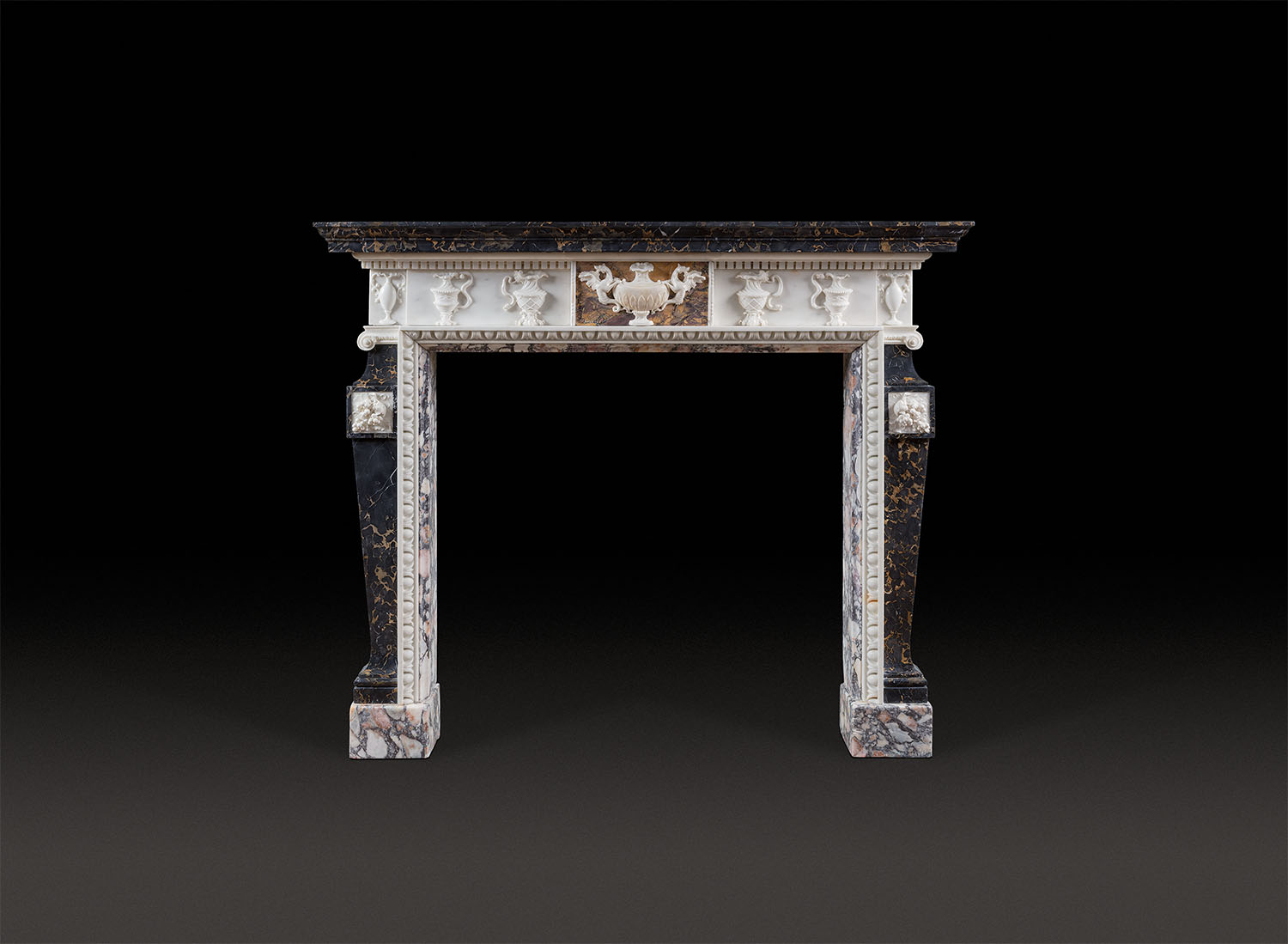
G302 (Sold)
An Exceptional & Rare Palladian Chimneypiece in Statuary, Breche, Sienna and Portoro Marbles, Attributed to William Kent
An exceptional George II, neo-Palladian chimneypiece attributed to William Kent (1685–1748) after an earlier Inigo Jones (1573–1652) design, almost certainly sculpted in the London workshop of Joseph Pickford (1684–1762). In Portoro, Breche de Serravezza, Siena and best white statuary marbles. English, circa 1740.
The breakfront shelf in Portoro Nero, fashioned from one slab with simple rounded mouldings, the frieze centred with a basso relief tablet decorated with a large wine ewer of globular shape resting on foliate socle with ribbed neck and scrolled spout with two handles on the sides in the form of winged, two footed, wyverns (dragons) in statuary on a contrasting Siena veneered background. Dragons were often used as supporters in armorial decoration and have been used here to give the tablet a statement of overpowering wealth and lineage, status and taste. This is flanked by panels carved with three elegant, confronted, shaped wine ewers of typical Kentian design, on circular socles with snake decorated handles and surmounted by a band of running dentils. The rectangular recessed end blockings with pear shaped wine ewers above the herm jambs which are in the form of three quarter, inverted, downward tapering obelisks in solid Portoro marble. The rectangular dies inlaid in white with Bacchic bunches of carved grapes, surmounted and capped by statuary Ionic volutes. The seven wine ewers and grapes are symbolic reminders to the viewer of the lavish and expensive entertainment they can expect to receive. The opening framed by egg and dart mouldings in statuary, lined with moulded Breche Serravezza slabs, the whole raised on foot blocks of the same marble.
This magnificent chimneypiece is typical of the 'new' English neo-Palladian style and exhibits the restrained, yet voluptuous, robust grandeur. This new taste had been happily imposed on England by the 'Apollo of the Arts' Lord Burlington and his 'High Priest' William Kent in the early 1720s. Inigo Jones’s original design, which Kent adapted and improved on, was illustrated in Isaac Ware (1704–1766), Designs of Inigo Jones and Others(including William Kent and Lord Burlington), plate 4, “Chimneypiece at Chiswick with its profile”, first published in 1731. Chiswick House was of course Burlington’s Villa, and the chimneypiece in statuary is still in situ. Inigo Jones also designed an identical fireplace for Somerset House (demolished in 1776–90). See John Harris and Gordon Higgott, Inigo Jones, Complete Architectural Drawings, 1989, plate 211.
Two other identically shaped chimneypieces, but obviously with different sculptural decorations are known, both in well documented Kentian houses. The first is at Holkham Hall, Norfolk, for Thomas Coke, in Portoro, Antico Verde and statuary marbles, in the' Strangers Wing', one of the seventeen Kent/Jones chimneypieces all carved by Joseph Pickford for the principle rooms. The second is in Kent's only surviving London house, 44 Berkeley Square, Westminster, for Lady Isabella Finch, 1742–4, in statuary marble, on the ground floor. Pickford is documented as supplying the pair of fireplaces in the Saloon. A third example was illustrated in Country Life, 24 August 1918, Bradbourne, Kent, 'Balcony' room in black and Gold and statuary marble and is reliably dated to pre-1747. A further related deign was illustrated by Sir William Chambers in his Treatise on the Decorative Part of Civil Architecture, 1759, again ascribed as being after a Jones/Kent design.
Height 60in (152.4cm) width 73¼in (186cm)
Internal height 45½in (114.3cm) width 48in (121.9cm)






